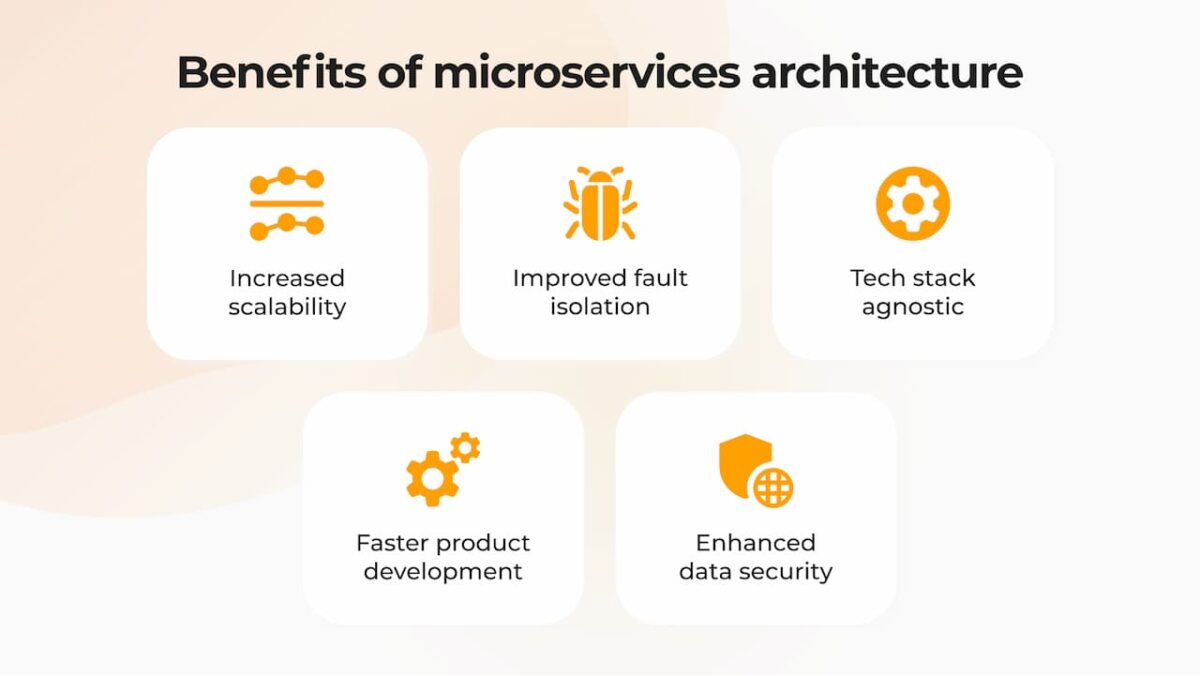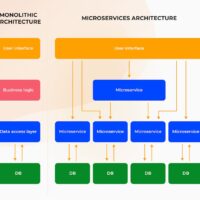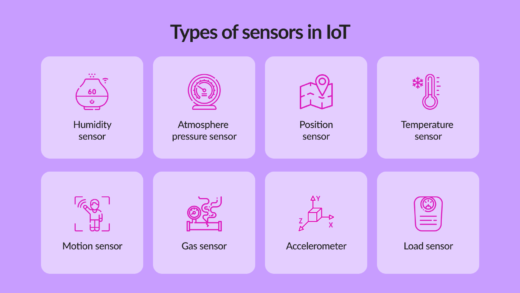Microservices architecture has progressed from an emerging trend to a leading approach. About 63% of IT companies entrust microservices when building software solutions.
In this article, we’ll take a closer look at what microservices architecture is, the advantages it offers, and the steps involved in implementing it.
The Meaning of Microservices Architecture
Microservices architecture refers to the architecture approach that designs software systems as a collection of small autonomous services shaped around a business domain. In microservices, each service is independent, has a separate codebase, and implements a single business capability. As a result, services are in charge of individual tasks and can interact using lightweight API to address complex business-related problems. The microservices approach works great for large projects where each applications’ component can be expanded separately. This reduces the time and cost connected to the entire app’s scalability because sole features can experience a considerable load.
Microservices Use Cases
Let’s see where companies apply the microservices approach:
- System migration
Mobile or web apps built on monolithic architecture can be relocated to cloud-based systems, including microservices.
- Digital content
You’re allowed to store your media content in a scalable repository and serve it straight to the website or mobile platforms
- Transactions
Payment service can be presented as an independent part of the process. This means payments are possible to receive while invoicing is disabled.
- Data management
A microservices system can scale cloud computing support for the modular toolkit for information processing.
Strong Sides of Microservices Architectures
Some software development companies are insecure about the effectiveness of the microservices approach. However, suppose you need to adjust some pieces of the application’s code. In the case of a traditional system, the entire codebase can be compromised because all the features and layers are tightly connected.
The microservices architecture facilitates and accelerates the software development process since the code is down into individual modules where each functionality is a standalone service. I’ve rounded up the core advantages of microservices to demonstrate why many IT organizations are actively implementing it.
Increased Scalability
Since microservices architecture is divided into small services that perform autonomously, it is allowed for smooth adding, modification, removal, or scale of all the demands for one specific component. This can be executed without disturbing other elements that encompass the software. When demand grows, the programmers only need to update or redirect more resources to the microservice influenced by the growing demands.
Enhanced Fault Isolation
Complex applications are more resilient to single component failure. Put differently, if one module fails, the software is capable of running independently, relying on other microservices.
Tech Stack Agnostic
The microservices experts can apply any programming language and technology stack for creating microservices-based applications. The choice will be limited only by project requirements and specialists’ skill sets. Moreover, it’s possible to connect microservices operating on different platforms. Still, services are able to interact with each other.
Faster Product Development
Imagine you have a large, complex project and require additional specialists working on your side. Then, the microservices approach is a great choice due to its added simplicity. It’s easier to figure out what each service stands for instead of delving into monolithic application development. It will result in quicker project development and reduce time to market.
Improved Data Security
Microservices system relies on special APIs to guarantee that only authorized users get access to the software. In addition, the team can monitor and control who enters the system and what data is browsed. Thus, it’s easier to comply with data security regulations such as HIPAA.

Things to Consider Before Microservices Architecture Implementation
As you can see, enterprises have advantages from microservices architecture. However, incorrect implementation can slow down the development process and may not recoup the investments made in this technology by not making the most out of it. Therefore, here are several steps you should follow to adopt a microservices model for better results.
Step 1. Determine Your Business Goals
First and foremost, you should understand whether your business needs such an approach and what goals you plan to achieve. Keep in mind that microservices architecture requires an additional workload. If you’re a startup or you already run a good working server, traditional architecture will suit you best.
Step 2. Cooperate with Experienced Specialists
Adapting your web or mobile platforms to a microservices architecture affects the established workflow performance. Since it implies not only a technological transformation but also an administrative one. That’s why you need to ensure that your team is experienced enough to develop their own microservices integration strategy.
Step 3. Decide on Programming Language
As mentioned earlier, the team can work with different coding languages and frameworks and launch applications on various platforms. That’s why the technology stack needs to be discussed before starting coding. That’s why it’s vital to order IT consulting services to be aware of which tools suit best.
Step 4. Keep Data Consistency
The designing microservices focus on data setting changes. Hence, sharing information storage between microservices should be prevented, even though it’s the quickest way to bring them together. Joint use will have a negative impact on the platform’s performance. Furthermore, any modifications done will change the implementation of a component and influence other components. This may also have an impact on software modernization services.
Step 5. Agile Frameworks
Since microservices architecture represents a number of independent modules, it needs small teams who will support the Agile software development methodology and take care of module maintenance. So if there is a large team of professionals, it should be divided into small ones and provide them with more discretion.
Step 6.Think Over a Good Monitoring System
How to understand that the migration process goes in the best way? It should be measured. It’s critical to track system performance and corresponding metrics. For example, you can set up notifications and automatic reports generation.
Wrapping Up
The microservices approach is flourishing and has an unprecedented impact on software development. It focuses on managing specific services rather than considering the application as a monolithic system. It leads to a smooth development process, strong data security, and greater compliance, thus improving users’ experience and business growth. However, microservices architecture adoption requires thoughtful preparation and proficiency in the field. So the best way to successfully implement microservices is to cooperate with an experienced vendor and discuss your plans with them.








